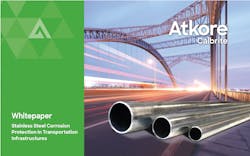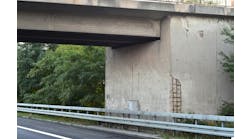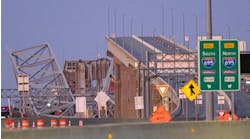Structure Owners and Users are Becoming Increasingly Aware of the Liabilities and the Costs of Corrosion
Carrying out remedial work, particularly on highway structures, bridges and tunnels, has led to a renewed interest in the use of stainless steel reinforcement, to minimize the risk of corrosion to structures exposed to marine / coastal environments, road de-icing salts, chlorides, and other harsh elements. The use of stainless steel conduit systems drastically reduces or even eliminates the need for costly shutdowns associated with repairs and therefore lessening the impact on traffic and safety.
During the 2008 financial crisis, trillions of dollars worldwide were pledged for infrastructure and transportation endeavors for the period of 2009-2015. Part of the US government’s stimulus program set aside $150 billion dollars for infrastructure repairs and new construction projects. A NACE International publication in 2011 stated: “in the long term, improving the condition of highway bridges can be affected by corrosion prevention measures during initial construction and appropriate maintenance.” Estimates suggest there are some 603,310 bridges in the United States that link more than 4 million miles of roadways. Approximately 200,000 of those bridges utilize stainless steel components such as fittings and conduit. Most of the money allotted for bridge projects is spent on maintenance. Steel is incorporated in a number of structural elements of a bridge such as towers and piers, girders, box girders, and trusses. Carbon, weathering, and stainless steel elements used in bridges are protected from corrosion by protective coatings. Although more expensive than carbon or weathering steel, stainless steel is being incorporated in innovative ways within bridges where lifespans are expected to be upwards of 50 years.
Cost Effectiveness of Stainless Steel in Bridge Construction
Programs with a focus on integrating corrosion-resistant alloys, such as stainless steel, should be implemented when one is designing equipment, selecting proper on-line corrosion monitoring techniques, or implementing maintenance programs in these environments to avert or minimize corrosion damage. Cost is another important concern for infrastructure and transportation network planners, not to mention the staggering safety risk of using subpar components. It is important to note that the proper alloy selection depends on the application and process. Implementing on-line corrosion monitoring will provide an indication of the corrosion severity of the environment. Due to its nickel content, which acts as a natural corrosion resistor, stainless steel conduit systems slow entropy, making it the best choice of material in environments with exposure to salt, acids, various chemicals and moisture interactions. Stainless steel is the safest and most economical conduit material for yearly dependability.
Stainless Steel is Naturally Anti-Corrosive
No metal, aside from gold and platinum, is completely corrosion proof, which results in stainless steel being the most widely used and economical option for harsh or corrosive environments. The basic resistance of stainless steel occurs because of its ability to form a protective coating on the metal surface. This coating is a “passive” film that resists further oxidation or rusting. The formation of this film is instantaneous in an oxidizing atmosphere such as air, water, or other fluids that contain oxygen. The lifespan of stainless steel is often equal to or longer than the lifespan of the structure, making the need for replacement rare.
Types of Stainless Steel
Type 304L stainless is manufactured with approximately 18% chromium and 8% nickel, allowing for use in a wide range of atmospheric environments. Type 316L stainless is manufactured with approximately 16% chromium, 12% nickel, and 3% Molybdenum. Type 316L’s Molybdenum and increased nickel content enhance the resistance to many industrial chemicals and solvents with specific resistance to chloride pitting.
Bridge designs and concrete mixes must be resistant to chloride-induced corrosion, as the primary cause of corrosion of steel bridges is the exposure of the steel to atmospheric conditions. This corrosion is greatly influenced by the exposure to salt spray and the very industrial environments in which they exist. With an expected 50 to 100-year service life, the extra cost to use stainless reinforcement on bridges is still the most cost-effective solution.
Regulatory Standards
There are three applicable standards for stainless steel conduit that govern its design and performance: UL6A, NEMA 4X, and ANSI C80.1. Underwriters Laboratories (UL) is a global independent safety science company that certifies, validates, tests, inspects, audits, and advises—providing knowledge and expertise regarding compliance and regulatory issues. The UL6A requirement covers electrical stainless steel rigid metal conduit steel elbows, couplings, and nipples for use as a metal raceway for the installation of wires and cables.
The National Electrical Manufacturers Association (NEMA) is the association of electrical equipment and medical imaging manufacturers. NEMA ensures technical standards that are in the best interests of both industry and end users, advocating policy and legislative matters. The 4X standard ensures protection against corrosion, windblown dust, and rain, splashing water, hose-directed water and damage from external ice formation in indoor or outdoor environments.
The American National Standards Institute (ANSI) is the primary United States standards and conformity assessment system, strengthening the market position within the global economy while assuring the safety and health of consumers and the environment. ANSI C80.1 standard covers the requirement for electrical rigid conduit for use as an electrical wire and cable raceway. A quality assurance program that fully supports and complies with the industry standards, as established by UL, ANSI and NEMA 4X is strongly recommended. Calbrite® produces various options that satisfy all three regulatory requirements while maintaining cost-effectiveness.
Easy to Install
Due to its high ductility, stainless steel can be bent to equally small bend radii as galvanized steel. Dies should be given a high polish and must be free from all surface blemishes to prevent marring the finish of the stainless steel parts. All metal has a certain amount of spring-back, also known as elastic recovery and 300 series stainless conduit has approximately 5% more than its galvanized steel counterparts. Minimal amounts of cutting and threading stainless conduit in the field with standard field equipment will suffice on smaller to moderate-sized jobs or modifications. For larger applications, it is recommended to purchase stainless steel threading dies and threading oil for better results and to reduce the chance of possible machinery malfunctions. With regular and routine maintenance, the corrosion resistance of stainless steel actually improves.
Planned maintenance of bridge equipment is essential. Planned maintenance consists of scheduled shutdown periods in order to inspect all equipment, and to refurbish or replace equipment that has failed due to corrosion or other failure mechanisms. Other materials, such as aluminum, galvanized steel, and PVC-Coated steel require more frequent intervals of equipment testing and remediation for corrosion.
In summary, stainless steel is often recognized as the premium material for a wide range of applications due to its excellent corrosion resistance, aesthetic appearance, strength, and ease of installation.
Editor's Note: Scranton Gillette Communications and the SGC Infrastructure Group are not liable for the accuracy, efficacy and validity of the claims made in this piece. The views expressed in this content do not reflect the position of the Roads & Bridges' Editorial Team.



